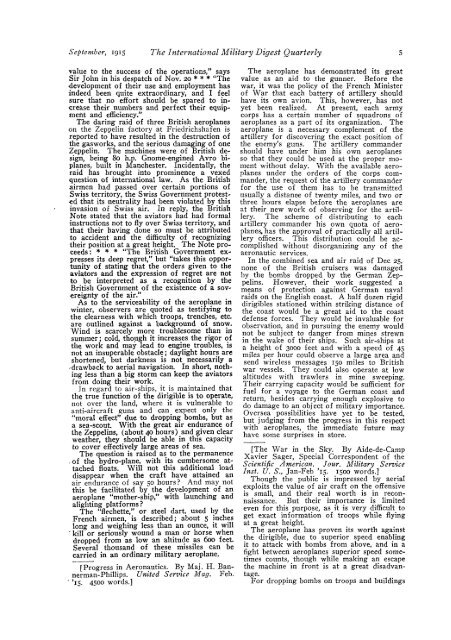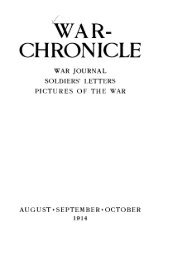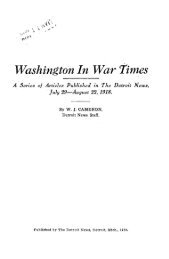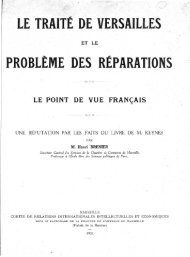International military digest, quarterly
International military digest, quarterly
International military digest, quarterly
You also want an ePaper? Increase the reach of your titles
YUMPU automatically turns print PDFs into web optimized ePapers that Google loves.
September, 1915 The <strong>International</strong> Military Digest Quarterly 5<br />
value to the success of the operations," says<br />
Sir John in his despatch of Nov. 20 * * * "The<br />
•development of their use and employment has<br />
indeed been quite extraordinary, and I feel<br />
sure that no effort should be spared to increase<br />
their numbers and perfect their equipment<br />
and efficiency."<br />
The daring raid of three British aeroplanes<br />
on the Zeppelin factory at Friedrichshafen is<br />
reported to have resulted in the destruction of<br />
the gasworks, and the serious damaging of one<br />
Zeppelin. The machines were of British design,<br />
being 80 h.p. Gnome-engined Avro biplanes,<br />
built in Manchester. Incidentally, the<br />
raid has brought into prominence a vexed<br />
question of international law. As the British<br />
airmen had passed over certain portions of<br />
Swiss territory, the Swiss Government protested<br />
that its neutrality had been violated by this<br />
invasion of Swiss air. In reply, the British<br />
Note stated that the aviators had had formal<br />
instructions not to fly over Swiss territory, and<br />
that their having done so must be attributed<br />
to accident and the difficulty of recognizing<br />
their position at a great height. The Note proceeds<br />
; * * * "The British Government expresses<br />
its deep regret," but "takes this opportunity<br />
of stating that the orders given to the<br />
aviators and the expression of regret are not<br />
to be interpreted as a recognition by the<br />
British Government of the existence of a sovereignty<br />
of the air."<br />
As to the serviceability of the aeroplane in<br />
winter, observers are quoted as testifying to<br />
the clearness with which troops, trenches, etc.<br />
are outlined against a background of snow.<br />
Wind is scarcely more troublesome than in<br />
summer ; cold, though it increases the rigor of<br />
the work and may lead to engine troubles, is<br />
not an insuperable obstacle ; daylight hours are<br />
shortened, but darkness is not necessarily a<br />
drawback to aerial navigation. In short, nothing<br />
less than a big storm can keep the aviators<br />
from doing their work.<br />
In regard to air-ships, it is maintained that<br />
the true function of the dirigible is to operate,<br />
not over the land, where it is vulnerable to<br />
anti-aircraft guns and can expect only the<br />
"moral effect" due to dropping bombs, but as<br />
a sea-scout. With the great air endurance of<br />
the Zeppelins, (about 40 hours) and given clear<br />
weather, they should be able in this capacity<br />
to cover effectively large areas of sea.<br />
The question is raised as to the permanence<br />
. of the hydro-plane, with its cumbersome attached<br />
floats. Will not this additional load<br />
disappear when the craft have attained an<br />
air endurance of say 50 hours? And may not<br />
this be facilitated by the development of an<br />
aeroplane "mother-ship," with launching and<br />
alighting platforms?<br />
The "fléchette," or steel dart, used by the<br />
French airmen, is described; about S inches<br />
long and weighing less than an ounce, it will<br />
"kill or seriously wound a man or horse when<br />
dropped from as low an altitude as 600 feet.<br />
Several thousand of these missiles can be<br />
carried in an ordinary <strong>military</strong> aeroplane.<br />
[Progress in Aeronautics. By Maj. H. Bannerman-Phillips.<br />
United Service Mag. Feb.<br />
' 'i5- 4SOO words.]<br />
The aeroplane has demonstrated its great<br />
value as an aid to the gunner. Before the<br />
war, it was the policy of the French Minister<br />
of War that each battery of artillery should<br />
have its own avion. This, however, has not<br />
yet been realized. At present, each army<br />
corps has a certain number of squadrons of<br />
aeroplanes as a part of its organization. The<br />
aeroplane is a necessary complement of the<br />
artillery for discovering the exact position of<br />
the enemy's guns. The artillery commander<br />
should have under him his own aeroplanes<br />
so that they could be used at the proper moment<br />
without delay. With the available aeroplanes<br />
under the orders of the corps commander,<br />
the request of the artillery commander<br />
for the use of them has to be transmitted<br />
usually a distance of twenty miles, and two or<br />
three hours elapse before the aeroplanes are<br />
at their new work of observing for the artillery.<br />
The scheme of distributing to each<br />
artillery commander his own quota of aeroplanes,<br />
has the approval of practically all artillery<br />
officers. _ This distribution could be accomplished<br />
without disorganizing any of the<br />
aeronautic services.<br />
In the combined sea and air raid of Dec 25,<br />
none of the British cruisers was damaged<br />
by the bombs dropped by the German Zeppelins.<br />
However, their work suggested a<br />
means of protection against German naval<br />
raids on the English coast. A half dozen rigid<br />
dirigibles stationed within striking distance of<br />
the coast would be a great aid to the coast<br />
defense forces. They would be invaluable for<br />
observation, and in pursuing the enemy would<br />
not be subject to danger from mines strewn<br />
in the wake of their ships. Such air-ships at<br />
a height of 3000 feet and with a speed of 45<br />
miles per hour could observe a large area and<br />
send wireless messages 150 miles to British<br />
war vessels. They could also operate at low<br />
altitudes with trawlers in mine sweeping.<br />
Their carrying capacity would be sufficient for<br />
fuel for a voyage to the German coast and<br />
return, besides carrying enough explosive to<br />
do damage to an object of <strong>military</strong> importance.<br />
Oversea possibilities have yet to be tested,<br />
but judging from the progress in this respect<br />
with aeroplanes, the_ immediate future may<br />
have some surprises in store.<br />
[The War in the Sky. By Aide-de-Camp<br />
Xavier Sager, Special Correspondent of the<br />
Scientific American. Jour. Military Service<br />
Inst. U. S., Jan-Feb '15. 1500 words.]<br />
Though the public is impressed by aerial<br />
exploits the value of air craft on the offensive<br />
is small, and their real worth is in reconnaissance.<br />
But their importance is limited<br />
even for this purpose, as it is very difficult to<br />
get exact information of troops while flying<br />
at a great height.<br />
The aeroplane has proven its worth against<br />
the dirigible, due to superior speed enabling<br />
it to attack with bombs from above, and in a<br />
fight between aeroplanes superior speed sometimes<br />
counts, though while making an escape<br />
the machine in front is at a great disadvantage.<br />
For dropping bombs on troops and buildings
















